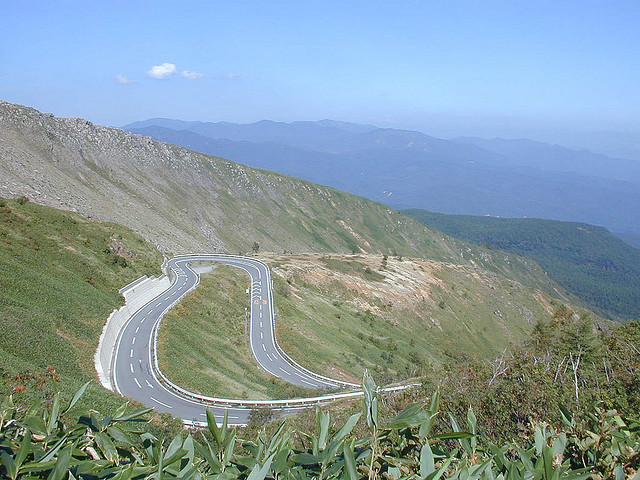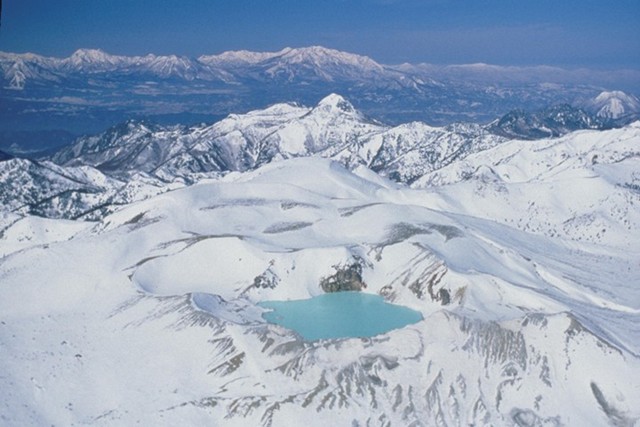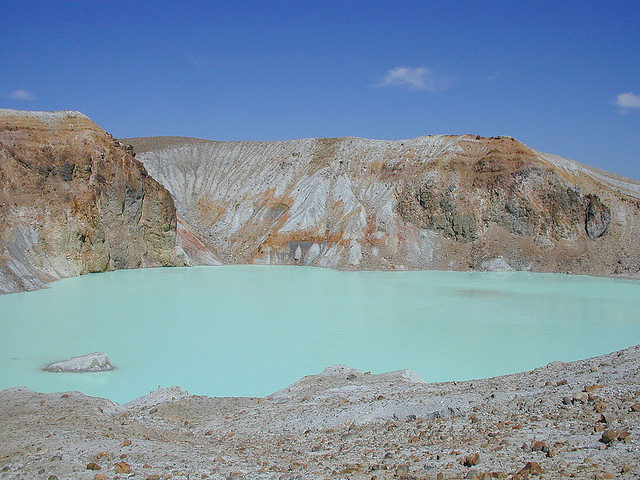Kusatsu-Shirane
2,160 metre-tall Kusatsu-Shirane towers over the town of Kusatsu in Gunma Prefecture, and while it hasn’t had a major eruption since 1983, it remains active. At the summit are several overlapping cones from past eruptions, and three crater lakes. The largest of these, Yugama, is the mountain’s chief attraction. It’s a huge turquoise-blue expanse of water, topped by yellow rafts of floating sulphur. It’s almost 300 metres wide and 30 metres deep, and it’s one of the most acidic lakes in the world. (The pH is 1.2, for those of you who understand what that means.)
Underwater vents ensure that Yugama is always warmer than the surrounding atmosphere, but just how much warmer depends on how active the volcano is. At present the lake is only warm, but a hundred years ago it reached boiling point. The acidity and sulphurous fumes ensure that the lake and its immediate surroundings are devoid of life, creating an eerie and desolate aura. Vents around the flanks of the volcano spout out steam and noxious gases, and become encrusted with yellow sulphur crystals. Hot mineral-rich water pours out of the mountain at numerous locations, and many acidic streams drain into the surrounding area.
Getting to Yugama is easy. Just ride a bus up the mountain from the Kusatsu Bus Terminal to Shirane Rest House (30 minutes, ¥1,000 each way, buses run once an hour). From there it’s only ten minutes’ walk along a paved trail. If that sounds too easy, you can hike up from the town, or get off the bus a bit earlier at the Shirane Volcano Ropeway, and ride that up the mountain instead (8 minutes, ¥1,500 return). The road up Kusatsu-Shirane is closed in winter (mid November to mid April), so there’s no way to get to Yugama at that time of year.
Kusatsu is a ski resort in winter, and a hot-spring resort all year round, and so has plenty of accommodation, and it’s a good base for exploring the surrounding area. To get there from Tokyo, the easiest way is to take a Limited Express Kusatsu No. 1 train from Ueno Station to Naganohara-Kusatsuguchi Station (around two and a half hours, ¥5,130), and then change for a bus to Kusatsu (30 minutes, ¥670). These direct trains are quite infrequent, so you may be better taking ordinary local trains and changing at Takasaki (this option takes around three to three and a half hours, and costs ¥2,940). You can also take a shinkansen (bullet train) to Takasaki (from Tokyo or Ueno stations), but it’ll then cost you up to ¥7,250, and you won’t necessarily get there that much faster. If you’ve got a car, Kusatsu is about two and a half hours’ drive from Tokyo.

This is one way to climb a mountain – the road goes almost to the top of Kusatsu-shirane, but is impassable in winter.
For more information about Kusatsu, Kusatsu-Shirane, and the surrounding area, take a look at the Kusatsu Onsen Tourism Association’s website.
Hakone Usu and Lake Toya


